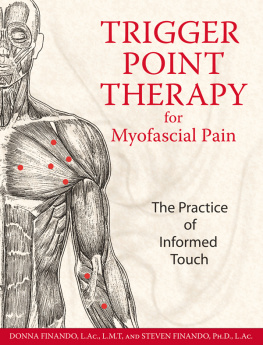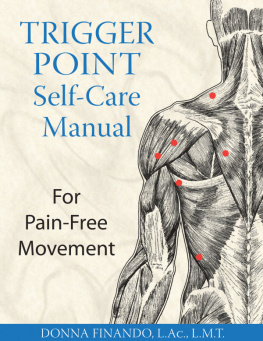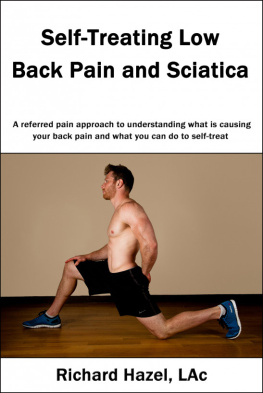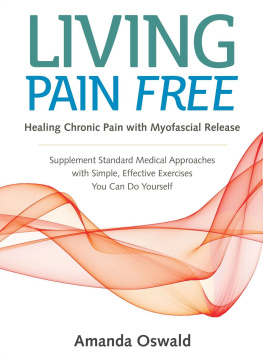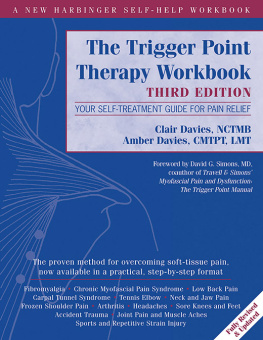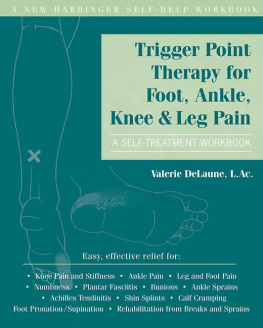Donna Finando - Trigger Point Therapy for Myofascial Pain: The Practice of Informed Touch
Here you can read online Donna Finando - Trigger Point Therapy for Myofascial Pain: The Practice of Informed Touch full text of the book (entire story) in english for free. Download pdf and epub, get meaning, cover and reviews about this ebook. year: 2005, publisher: Healing Arts Press, genre: Romance novel. Description of the work, (preface) as well as reviews are available. Best literature library LitArk.com created for fans of good reading and offers a wide selection of genres:
Romance novel
Science fiction
Adventure
Detective
Science
History
Home and family
Prose
Art
Politics
Computer
Non-fiction
Religion
Business
Children
Humor
Choose a favorite category and find really read worthwhile books. Enjoy immersion in the world of imagination, feel the emotions of the characters or learn something new for yourself, make an fascinating discovery.
- Book:Trigger Point Therapy for Myofascial Pain: The Practice of Informed Touch
- Author:
- Publisher:Healing Arts Press
- Genre:
- Year:2005
- Rating:5 / 5
- Favourites:Add to favourites
- Your mark:
- 100
- 1
- 2
- 3
- 4
- 5
Trigger Point Therapy for Myofascial Pain: The Practice of Informed Touch: summary, description and annotation
We offer to read an annotation, description, summary or preface (depends on what the author of the book "Trigger Point Therapy for Myofascial Pain: The Practice of Informed Touch" wrote himself). If you haven't found the necessary information about the book — write in the comments, we will try to find it.
Donna Finando: author's other books
Who wrote Trigger Point Therapy for Myofascial Pain: The Practice of Informed Touch? Find out the surname, the name of the author of the book and a list of all author's works by series.
Trigger Point Therapy for Myofascial Pain: The Practice of Informed Touch — read online for free the complete book (whole text) full work
Below is the text of the book, divided by pages. System saving the place of the last page read, allows you to conveniently read the book "Trigger Point Therapy for Myofascial Pain: The Practice of Informed Touch" online for free, without having to search again every time where you left off. Put a bookmark, and you can go to the page where you finished reading at any time.
Font size:
Interval:
Bookmark:
Trigger Point Therapy for Myofascial Pain
The Practice of Informed Touch
DONNA FINANDO, L.AC., L.M.T.
AND
STEVEN FINANDO, PH.D., L.AC.

Healing Arts Press
Rochester, Vermont

To our patients, from whom we have learned much about the nature
of pain and how to treat it. And to our students, who required us
to think about, order, and communicate what we practice.
ACKNOWLEDGMENTS
J anet Travell, M.D., whose life work in clarifying and ordering myofascial pain syndromes has provided the reality base that has eluded so many others. Her work has demonstrated beyond any doubt that pain results from muscular dysfunction. So many in the medical community have, until very recently, disregarded the musculature as a source of pain and suffering. Through Janet Travells lifelong workher systematic efforts to identify and chart pain patterns associated with muscular trigger points and the various means with which to eliminate themwe have been given the basis for treatment of chronic pain suffered by so many for so long.
Mark Seem, Ph.D., who has strived to evolve the application of Dr. Travells work to the field of acupuncture. Understanding the value of acupuncture as physical medicine in the treatment and resolution of pain, Mark has dedicated his efforts to bringing acupuncture into the forefront of American health care. We would also like to thank Mark for coining the phrase informed touch, which so clearly describes what we seek to accomplish through our work.
Arya Niellsen, L.Ac., Steven Rosenblatt, M.D., and Robert Ruffalo, D.C., whose feedback has helped in making this book most useful for Eastern and Western practitioners alike.
Jane Waski, whose skillful drawings demonstrate stretches that are so beautifully rendered that we can feel and sense the stretch of the muscle as we look at them.
Susan Bubenas and the staff at Polan and Waski, whose graphic capabilities have been critical in the production of illustrations that so clearly identify muscle and trigger point.
Susan Davidson of Healing Arts Press, who has helped us clarify, order, and evolve this work. Her help, her encouragement, her careful and critical editors eye, her patience, and her dedication to this project have been invaluable to the evolution of this manual.
INTRODUCTION
A GATHERING OF FORCES
Toward an Era of Interdisciplinary Cooperation in the Treatment of Pain
T he field of pain management, specifically the treatment of myofascial pain syndromes, has become a meeting ground for health professionals. Acupuncturists, medical doctors, and practitioners of various manual and physical therapies who previously had little to say to one another are now collaborating in ways that are unprecedented in the history of American health care. The reason for the development of such interdisciplinary communication is the growing recognition that myofascial syndromes are the basis of a huge segment of patient complaint, and associated allocation of resources, within our health care system.
Patients with myofascial pain syndromes are seeking the help of family physicians, internists, orthopedists, neurologists, rheumatologists, osteopaths, physiatrists, psychiatrists, and anesthesiologists. Dentists, particularly specialists in temporomandibular joint syndrome, regularly see patients presenting with myofascial pain. In addition, acupuncturists, chiropractors, physical therapists, occupational therapists, massage therapists, and psychotherapists are all encountering patients in pain. Conferences on pain treatment have increasingly become polyprofessional experiences.
It is possible that, through health professionals mutual interest in the treatment of myofascial pain syndromes, true complementary medicine may emerge as a reality in the United States. Complementary medicine here refers to the use of conventional medical practices in conjunction with recently emerging Oriental and other body-therapy approaches, providing a coordinated treatment strategy that is best for the patient. This differs from the alternative medical model, which tends toward a competitive concept of health care, ultimately forcing a division between itself and conventional medical practices that may not, in the long run, be of the greatest benefit to patients. At this point in our medical history the fact is that health professionals from widely varying disciplines are talking to each other with a newfound respect, and the result may be the fostering of a cooperative spirit that will help millions of people who are in pain.
This book, a field manual for any health professional dealing with myofascial syndromes, therefore serves a vital purpose. Its aim is to simplify and order the vast amounts of information related to the evaluation and treatment of myofascial pain. Utilizing our many years of clinical and teaching experience, we have endeavored to address the concerns and desires of health care providers for a manual that can assist in evaluating a patient, defining the presenting condition, and guiding treatment of that condition. It is assumed that the reader has some knowledge of myology; therefore no effort is made to replicate the extensive background and theoretical discussion found in seminal works on myofascial pain, such as those of Janet Travell and David Simons and P. E. Baldry. Instead, in addition to the technical core of the manual, introductory chapters discuss topics that will facilitate communication among the many professions concerned with this area of study.
We begin with a discussion on the nature of muscles and trigger points, useful as review for those who treat primarily from this perspective and a good introduction for those entering the field. We then examine the phenomenology of qi, that elusive concept of energy that is the foundation of all Oriental medical practices. Qi is examined from the perspective of myofascial syndromes, making it a more accessible and useful metaphor for all health professionals. It is hoped that an expanded view of the concept of qi will help facilitate, rather than hinder, communication between practitioners of Eastern and Western medicine.
Since muscle-palpation skills are at the center of effective evaluation and treatment, we next discuss the nature and process of palpation. Because a relative few practitioners are adept in this type of palpation, some guiding principles are offered to help those who are evolving palpation skills. A chapter outlining the fundamental approaches to evaluation and treatment of myofascial pain syndromes helps establish common ground among health professionals, in the realization that there are behavioral elements in treatment that are shared, independent of ones particular training or orientation. Thus the acupuncturist, neurologist, and physical therapist, while differing in perspective regarding myofascial pain syndromes, all ultimately share similar behaviors in evaluation and treatment. A brief overview of how to use the clinical body of the manual, with a description of the information provided for each muscle, finishes the introduction.
In the final analysis, since this is a manual for the health professional who encounters patients presenting with pain on a daily basis, the approach is pragmatic and behavioral. In the interest of expanding our scientific knowledge, it is enticing to determine underlying mechanisms for pain that strengthen our theoretical understanding. However, it is far more important that the practitioner in the field ascertain what helps patients, and learns how to effect that help. This book is about how, not why.
CHAPTER 1
THE NATURE OF MUSCLES AND TRIGGER POINTS
Next pageFont size:
Interval:
Bookmark:
Similar books «Trigger Point Therapy for Myofascial Pain: The Practice of Informed Touch»
Look at similar books to Trigger Point Therapy for Myofascial Pain: The Practice of Informed Touch. We have selected literature similar in name and meaning in the hope of providing readers with more options to find new, interesting, not yet read works.
Discussion, reviews of the book Trigger Point Therapy for Myofascial Pain: The Practice of Informed Touch and just readers' own opinions. Leave your comments, write what you think about the work, its meaning or the main characters. Specify what exactly you liked and what you didn't like, and why you think so.

